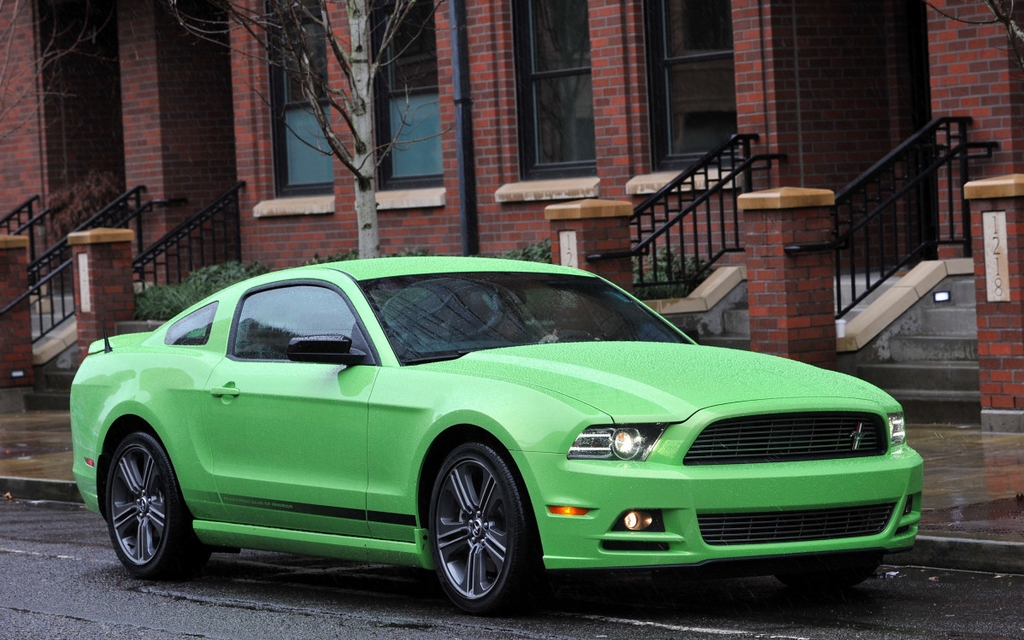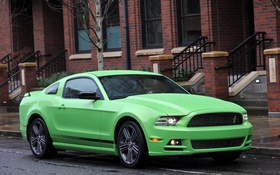2013 Ford Mustang: The V6? A real bargain!

| Strong points |
|
|---|---|
| Weak points |
|
Over the years, Ford has struck a very nice balance in its Mustang line-up, with the Boss 302 and Shelby GT joining the V6 and GT. What’s more, the Mustang’s looks offer a perfect blend of traditional and modern sensibilities. And recent changes have made the passenger compartment and dashboard reasonably sophisticated. At first, their aim to improve the line-up for 2013 seemed unrealistic, but the Mustang’s engineers and stylists have managed to make this coupe and cabriolet more attractive than ever.
The same cool look
When a car is popular and its appearance is widely loved, it doesn’t make sense to change it. Or does it? Over time, cars have to refresh their looks in order to stay with the times and keep up with the competition.
Among the most notable changes, the new Mustang features a redesigned front grille as well as the front air splitter. On the GT’s hood, functional heat extractors have been specially designed to extract hot air from the engine block. The rocker panel mouldings are now the same colour as the body, and the tail end is equipped with a shiny black panel that links to tail lights, which integrate three vertical rows of LED lights. In front, the headlights feature discharge lamps and also include two bars of individual LED lights.
Speaking of lighting, the outside rearview mirrors on the 2013 edition are equipped lamps that project the famous Mustang emblem on the ground whenever the unlock button is pushed. They truly thought of everything.
It should also be noted that you can now order Recaro seats on the V6 and GT versions. These seats used to be exclusive to the Boss 302 and Shelby GT500. The passenger compartment has also undergone several touch-ups. For those who want, a performance measuring system called Track Apps is available. Information is displayed on a 4.2-inch LCD screen located between the tachometer and the speedometer, and you navigate using a five-way control button situated on the steering wheel. Depending on the settings, it can tell you about g-force, acceleration times for 0-30 mph, 0-60 mph and 0-100 mph, an eighth of a mile and a quarter-mile intervals. Moreover, automatic and countdown starts, along with drag racing start lights, are available. This screen also displays the stopping distances for 60 to 0 mph and 100 to 0 mph intervals. It keeps track of your best times and records. Drivers can also view their latest results and history on the acceleration and brake performance screens. (Editor’s note: we’re still waiting for confirmation from Ford on whether this system will be available in metric in Canada).
If you prefer music over performance, you’ll be glad to know that there are two audio systems available. The Shaker MC system offers eight speakers and 370 watts of power; while the Shaker Pro system offers nine speakers and 550 watts of power.
More horses
As for mechanics, all of the engines are back. The 3.7-litre V6 engine produces 305 horses, which is more than enough. In the GT, the 5.0-litre V8 now generates 420 horses, some 20 less than what the Boss 302 delivers. Finally, there’s the Shelby GT 500 whose power is now 650 horses, making it the most powerful V8 engine in the world.
This year, buyers can opt for a six-speed SelectShift automatic gearbox that allows you change gears manually. Like last year, the Boss 302 and Shelby GT 500 come with a six-speed manual gearbox.
The Mustang V6: A real steal!
During the presentation in Portland, Oregon, the Mustang I drove had a V6 engine and six-speed SelectShift automatic transmission. It was also equipped with the Track Apps information system. Although this accessory is just meant for track driving, I always get a kick out of seeing the lateral braking acceleration data in normal driving conditions.
With the stats and acceleration times of the more powerful versions are undeniably impressive, I’m convinced that the V6 is more than enough for your everyday driving needs. This engine and its 305 horses translate into very decent performances without excessive fuel consumption. The V6 propels the car from 0-100 km/hr in less than seven seconds, while its fuel consumption is just over 7 L/100 km.
The car that I tested was fitted with Pirelli P Zero tires. These turned out to be very comfortable for high-performance tires. The steering is well assisted and the handling is practically flawless. It understeers slightly in certain situations, but it’s all easily controlled. Basically, it has nearly perfect balance.
I say “nearly” because I had a minor problem while driving this Mustang. The road was dotted with gravel after several successive days of heavy rain, and the car suddenly skidded in a turn and came to a stop on the side of a cliff. Needless to say, I was upset at myself. Fortunately, the only part of me that was hurt was my pride. And the experience proved, for once and for all, that Mustangs are solidly built!
Despite this incident, I must admit that the Mustang line-up has been improved for 2013 and is more attractive than ever.











